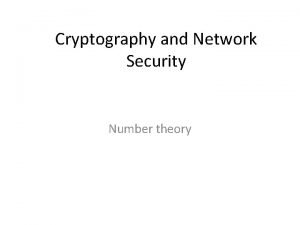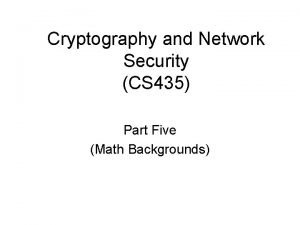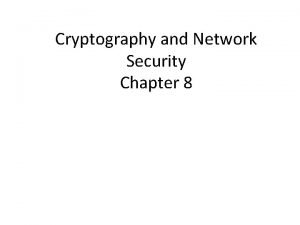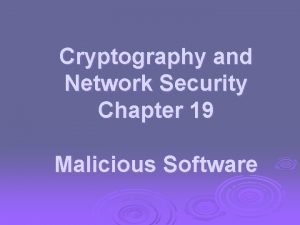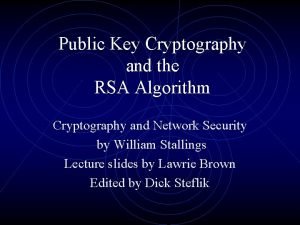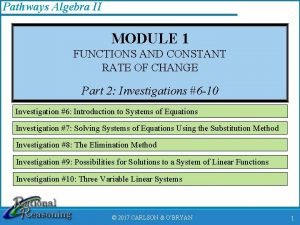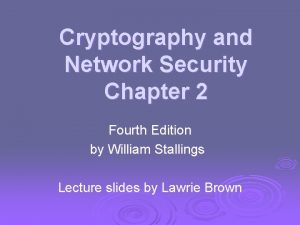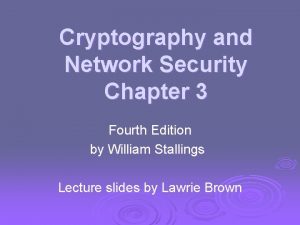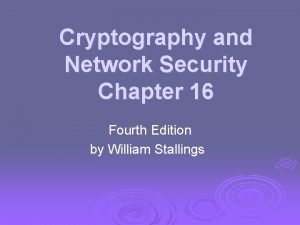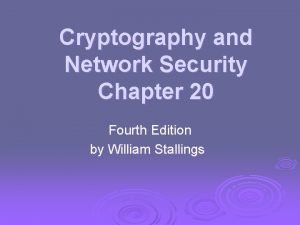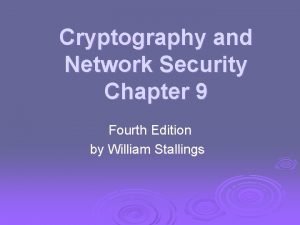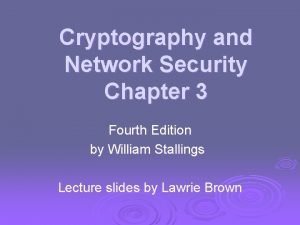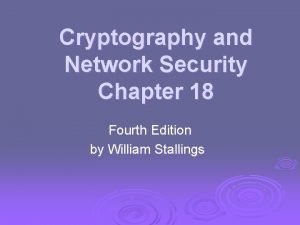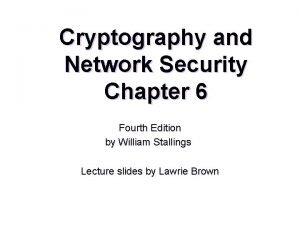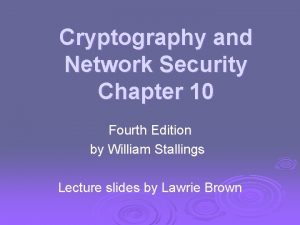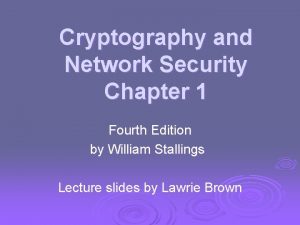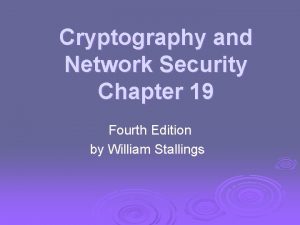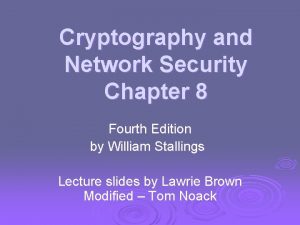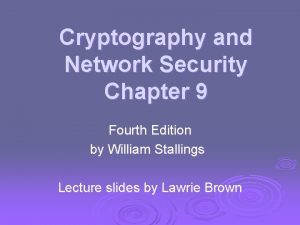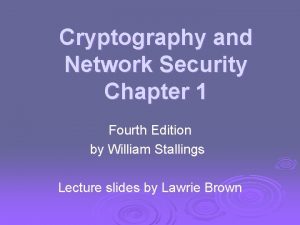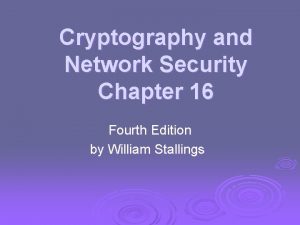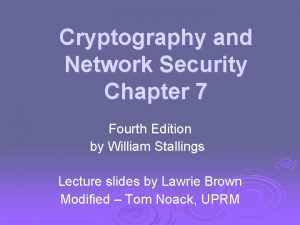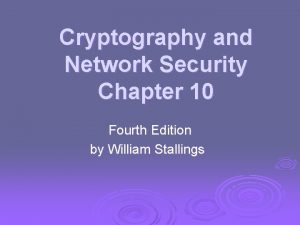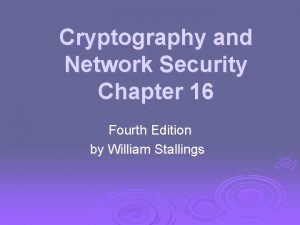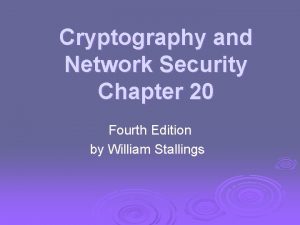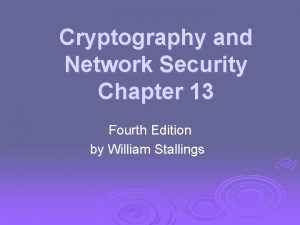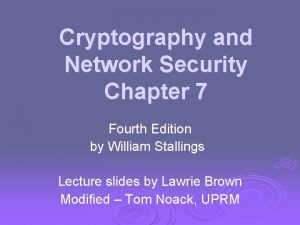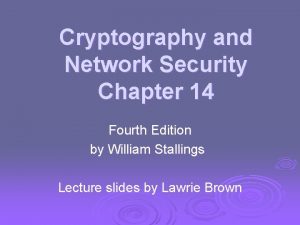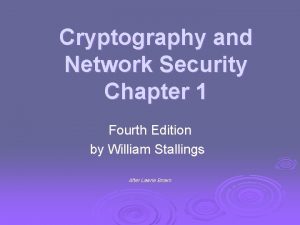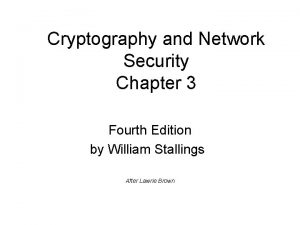Cryptography and Network Security Chapter 13 Fourth Edition





























- Slides: 29

Cryptography and Network Security Chapter 13 Fourth Edition by William Stallings Lecture slides by Lawrie Brown & Süleyman KONDAKCI

Digital Signatures (DS) Ø Message authentication does not address issues of lack of trust Ø digital signatures provide the ability to: l l l verify author, date & time of signature authenticate message contents be verified by third parties to resolve disputes Ø DS includes message authentication function with additional capabilities

Digital Signature Properties must depend on the message signed Ø must use information unique to sender Ø l to prevent both forgery and denial must be relatively easy to produce Ø must be relatively easy to recognize & verify Ø be computationally infeasible to forge Ø l l Ø with new message for existing digital signature with fraudulent digital signature for given message be practical to save digital signature in storage

Direct Digital Signatures Ø involve only sender & receiver Ø assumed receiver has sender’s public-key Ø digital signature made by sender signing entire message or hash with private-key Ø can encrypt using receivers public-key Ø important that sign first then encrypt message & signature Ø security depends on sender’s private-key

Digital Signature Model

Digital Signature Model

Arbitrated Digital Signatures Ø involves use of an arbiter who l l validates any signed message then dated and sent to recipient Ø requires suitable level of trust in arbiter Ø can be implemented with either private or public-key algorithms Ø arbiter may or may not see message

Authentication Protocols Ø used to convince parties of each others identity and to exchange session keys Ø may be one-way or mutual Ø key issues are l l confidentiality – to protect session keys timeliness – to prevent replay attacks Ø published protocols are often found to have flaws and need to be modified

Using Symmetric Encryption Ø Can use a two-level hierarchy of keys Ø usually with a trusted Key Distribution Center (KDC) l l l each party shares own master key with KDC generates session keys used for connections between parties master keys used to distribute these to them

Needham-Schroeder Protocol Used by 2 parties who both trust a common key server Ø original third-party key distribution protocol Ø for session between A B mediated by KDC Ø protocol overview is: Ø 1. A->KDC: IDA || IDB || N 1 2. KDC -> A: EKa[Ks || IDB || N 1 || EKb[Ks||IDA] ] 3. A -> B: EKb[Ks||IDA] 4. B -> A: EKs[N 2] -> B: making EKs[f(some N 2)]changes on N 2 so that owner of N 2 can verify f(N 25. ) is. A a function the correct receipt of N 2, e. g. , F(23456)= 23456+1. That 1 is the verifier code.

Needham-Schroeder Protocol Ø used to securely distribute a new session key for communications between A & B Ø but is vulnerable to a replay attack if an old session key has been compromised l then message 3 can be resent convincing B that is communicating with A Ø modifications to address this require: l l timestamps using an extra nonce

Using Public-Key Encryption Ø have a range of approaches based on the use of public-key encryption Ø need to ensure have correct public keys for other parties Ø using a central Authentication Server (AS) Ø various protocols exist using timestamps or nonces

Denning Authentication Server Protocol Ø Denning presented the following: 1. A -> AS: IDA || IDB 2. AS -> A: EPRas[IDA||PUa||T] || EPRas[IDB||PUb||T] 3. A -> B: EPRas[IDA||PUa||T] || EPRas[IDB||PUb||T] || EPUb[EPRa[Ks||T]] Note that to avoid the risk of exposure by the AS session key is chosen by A, hence AS need not be trusted to protect it Ø timestamps prevent replay attacks but require synchronized clocks Ø

One-Way Authentication The recipient wants some assurance that the message is from the alleged sender. One-Way Authentication addresses these requirements. Ø Required when sender & receiver communicate in connectionless mode (eg. email) Ø Have header in clear text so can be delivered by email systems Ø May want contents of body protected & sender authenticated Ø

One-Way Authentication Using Symmetric Encryption Ø can refine use of KDC but can’t have final exchange of nonces: 1. A->KDC: IDA || IDB || N 1 2. KDC -> A: EKa[Ks || IDB || N 1 || EKb[Ks||IDA] ] 3. A -> B: EKb[Ks||IDA] || EKs[M] Ø does not protect against replays l could rely on timestamp in message, though email delays make this problematic

One-Way Authentication Using Public-Key Approaches Ø have seen some public-key approaches Ø if confidentiality is major concern, can use: A->B: EPUb[Ks] || EKs[M] l has encrypted session key, encrypted message Ø if authentication needed use a digital signature with a digital certificate: A->B: M || EPRa[H(M)] || EPRa[T||IDA||PUa] l with message, signature, certificate

Digital Signature Standard (DSS) US Govt approved signature scheme Ø designed by NIST & NSA in early 90's Ø published as FIPS-186 in 1991 Ø revised in 1993, 1996 & then 2000 Ø uses the SHA hash algorithm Ø DSS is the standard, DSA is the algorithm Ø FIPS 186 -2 (2000) includes alternative RSA & elliptic curve signature variants Ø

El. Gamal Digital Signatures Ø signature variant of El. Gamal, related to D-H l l so uses exponentiation in a finite (Galois) with security based difficulty of computing discrete logarithms, as in D-H Ø use private key for encryption (signing) Ø uses public key for decryption (verification) Ø each user (eg. A) generates their key l l chooses a secret key (number): 1 < x. A < q-1 x. A compute their public key: y. A = a mod q

El. Gamal Digital Signature Ø Alice signs a message M to Bob by computing l l l Ø the hash m = H(M), 0 <= m <= (q-1) chose random integer K with 1 <= K <= (q-1) and gcd(K, q-1)=1 k compute temporary key: S 1 = a mod q compute K-1 the inverse of K mod (q-1) compute the value: S 2 = K-1(m-x. AS 1) mod (q-1) signature is: (S 1, S 2) any user B can verify the signature by computing l l l m V 1 = a mod q V 2 = y. AS 1 S 1 S 2 mod q signature is valid if V 1 = V 2

El. Gamal Signature Example use field GF(19) q=19 and a=10 Ø Alice computes her key: Ø l Ø mod 19 = 4 Alice signs message with hash m=14 as (3, 4): l l Ø 16 A chooses x. A=16 & computes y. A=10 choosing random K=5 which has gcd(18, 5)=1 5 computing S 1 = 10 mod 19 = 3 finding K-1 mod (q-1) = 5 -1 mod 18 = 11 computing S 2 = 11(14 -16. 3) mod 18 = 4 any user B can verify the signature by computing l l l 14 V 1 = 10 mod 19 = 16 V 2 = 43. 34 = 5184 = 16 mod 19 since 16 = 16 signature is valid

Schnorr Digital Signatures Ø also uses exponentiation in a finite (Galois) l security based on discrete logarithms, as in D-H Ø minimizes message dependent computation l multiplying a 2 n-bit integer with an n-bit integer Ø main work can be done in idle time prime modulus p l l using a p– 1 has a prime factor q of appropriate size typically p 1024 -bit and q 160 -bit numbers

Schnorr Key Setup Ø choose suitable primes p , q q Ø choose a such that a = 1 mod p Ø (a, p, q) are global parameters for all Ø each user (eg. A) generates a key l l chooses a secret key (number): 0 < -s. A compute their public key: v. A = a s. A < mod q q

Schnorr Signature Ø user signs message by choosing random r with 0<r<q and computing x = ar mod p l concatenate message with x and hash result to computing: e = H(M || x) l computing: y = (r + se) mod q l signature is pair (e, y) Ø any other user can verify the signature as follows: y e mod p l computing: x' = a v l verifying that: e = H(M || x’) l

Digital Signature Algorithm (DSA) Ø creates a 320 bit signature Ø with 512 -1024 bit security Ø smaller and faster than RSA Ø a digital signature scheme only Ø security depends on difficulty of computing discrete logarithms Ø variant of El. Gamal & Schnorr schemes

Digital Signature Algorithm (DSA)

DSA Key Generation Ø have shared global public key values (p, q, g): l l choose 160 -bit prime number q choose a large prime p with 2 L-1 < p < 2 L • where L= 512 to 1024 bits and is a multiple of 64 • such that q is a 160 bit prime divisor of (p-1) l choose g = h(p-1)/q • where 1<h<p-1 and h(p-1)/q mod p > 1 Ø users choose private & compute public key: l l choose random private key: x<q compute public key: y = gx mod p

DSA Signature Creation Ø to sign a message M the sender: l l generates a random signature key k, k<q NB! k must be random, be destroyed after use, and never be reused Ø then computes signature pair: r = (gk mod p)mod q s = [k-1(H(M)+ xr)] mod q Ø sends signature (r, s) with message M

DSA Signature Verification Ø having received M & signature (r, s) Ø to verify a signature, recipient computes: w = u 1= u 2= v = s-1(mod q) (H(M). w)(mod q) (rw)(mod q) (gu 1 yu 2(mod p)) (mod q) Ø if v=r then signature is verified Ø see book web sitehe text for details!

DSS Overview
 Modulo table
Modulo table Cryptography and network security 6th edition pdf
Cryptography and network security 6th edition pdf Cryptography and network security 4th edition
Cryptography and network security 4th edition Pearson cryptography and network security
Pearson cryptography and network security Wireless security in cryptography
Wireless security in cryptography Introduction to network security and cryptography
Introduction to network security and cryptography Number theory in network security
Number theory in network security Firewall base layer
Firewall base layer Authentication in cryptography and network security
Authentication in cryptography and network security Intruders in cryptography and network security
Intruders in cryptography and network security Primitive root
Primitive root Source
Source Fermat's theorem in cryptography and network security
Fermat's theorem in cryptography and network security Multiplicative inverse
Multiplicative inverse Digital signature in cryptography and network security
Digital signature in cryptography and network security Gcd(1970,1066)
Gcd(1970,1066) Pgp in cryptography and network security
Pgp in cryptography and network security Euler's theorem in cryptography and network security
Euler's theorem in cryptography and network security Malicious software in cryptography
Malicious software in cryptography Introduction to cryptography and network security
Introduction to cryptography and network security Rsa algorithm in cryptography and network security
Rsa algorithm in cryptography and network security Introduction to cryptography and network security
Introduction to cryptography and network security Expert systems: principles and programming, fourth edition
Expert systems: principles and programming, fourth edition Network security essentials 5th edition
Network security essentials 5th edition Network security essentials 5th edition
Network security essentials 5th edition Project 2 fourth edition
Project 2 fourth edition Pathways algebra 2 fourth edition answer key
Pathways algebra 2 fourth edition answer key Ethics in information technology fourth edition
Ethics in information technology fourth edition Ethics in information technology fourth edition
Ethics in information technology fourth edition Vertical line code in html
Vertical line code in html












